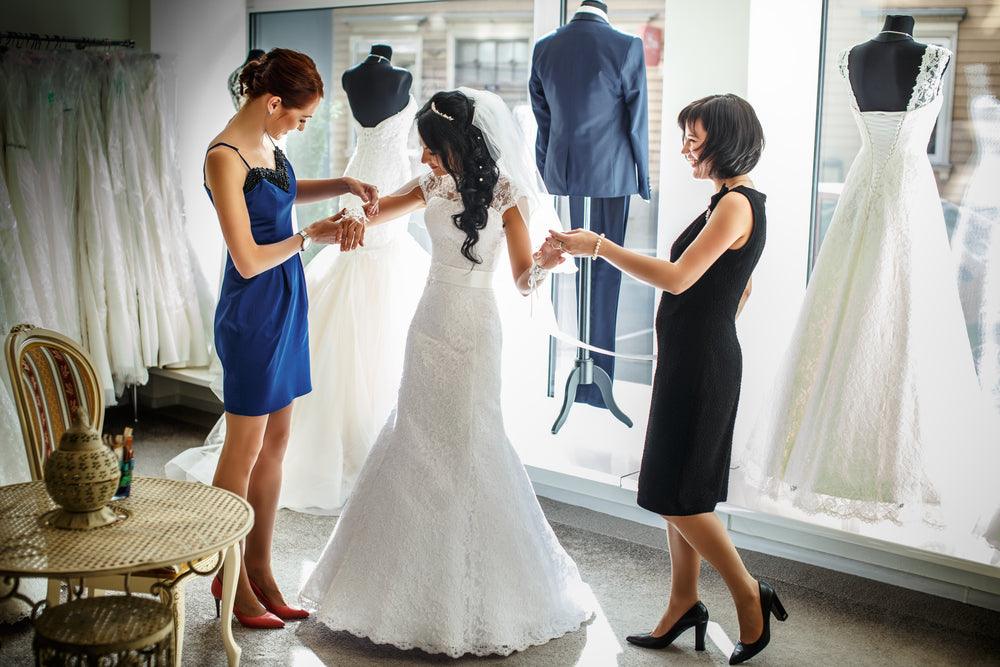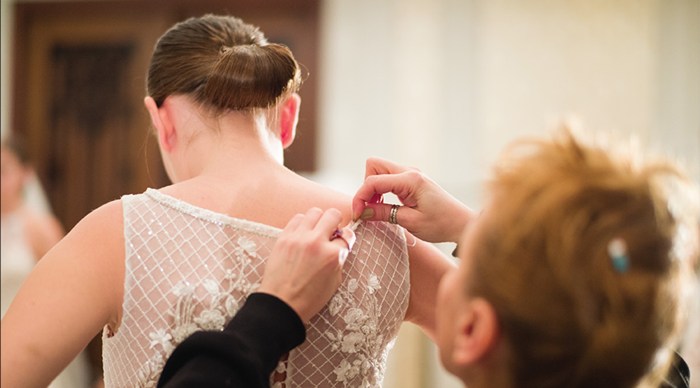Wedding Dress Shopping Timeline

Source: rusticandmain.com
When should i get my wedding dress – Choosing the perfect wedding dress is a significant part of wedding planning. Understanding the ideal timeline for dress shopping ensures a stress-free experience and allows ample time for alterations and fittings. This guide Artikels key considerations to help you navigate this process effectively.
Typical Wedding Planning Timeline and its Impact on Dress Shopping, When should i get my wedding dress
A typical wedding planning timeline spans 12-18 months, with dress shopping ideally beginning 9-12 months before the wedding date. This allows sufficient time for dress selection, alterations, and potential delays. Starting earlier is advantageous for popular designers or unique designs requiring longer lead times.
Relationship Between Dress Selection and Other Wedding Preparations
Dress selection influences other aspects of wedding planning, such as the overall aesthetic, bridesmaid dresses, and even the venue’s style. The dress should complement the wedding’s theme and venue. For instance, a formal ballroom wedding requires a different style of dress than a beach wedding.
Sample Wedding Dress Shopping Timeline
This sample timeline provides a structured approach to wedding dress shopping:
- 12-15 months before wedding: Begin researching designers, styles, and boutiques.
- 10-12 months before wedding: Schedule initial dress appointments. Start browsing online for inspiration.
- 8-10 months before wedding: Select your dress and order it. Pay the deposit.
- 6-8 months before wedding: First fitting. Discuss any necessary alterations.
- 4-6 months before wedding: Second fitting. Fine-tune alterations.
- 2-4 months before wedding: Final fitting. Ensure everything fits perfectly.
Comparison of Early vs. Late Dress Shopping Timelines
The decision of when to start shopping depends on various factors. Consider these pros and cons:
| Factor | Early Shopping (9-12 months before) | Late Shopping (6-8 months before) |
|---|---|---|
| Pros | More time for alterations, less stress, wider selection, ability to order custom designs | Potentially find last-minute deals, faster turnaround for alterations if dress is readily available |
| Cons | May change style preferences, longer wait time for alterations, may forget dress details | Limited selection, rushed alterations, higher stress levels |
Dress Selection Process
Finding the perfect wedding dress involves careful planning and consideration of various factors. A structured approach will enhance the experience and ensure a satisfying outcome.
Steps Involved in Finding the Perfect Wedding Dress
The process typically involves several steps:
- Research and Inspiration Gathering
- Budget Setting
- Appointment Scheduling
- Dress Shopping and Selection
- Ordering the Dress
Tips for Efficient Dress Shopping
Efficient dress shopping involves strategic planning and resource management. Consider these tips:
- Set a realistic budget.
- Schedule appointments in advance.
- Bring a small entourage.
- Take photos and videos.
Importance of Considering Personal Style, Venue, and Season
The wedding dress should reflect the bride’s personal style, complement the venue, and be appropriate for the season. A rustic venue may suit a bohemian-style dress, while a formal ballroom may require a more classic or elegant gown. The fabric and style should also consider the weather.
Checklist of Essential Items to Bring to Dress Appointments
To ensure a smooth and productive appointment, bring these items:
- Undergarments similar to what will be worn under the dress.
- Comfortable shoes.
- Pictures of desired styles.
- Budget information.
- A notepad and pen.
Dress Alterations and Fittings
Alterations are crucial for ensuring the dress fits perfectly. Careful planning and selection of a reputable seamstress are essential.
Typical Timeframe Needed for Alterations and Fittings
Allow 4-6 months for alterations, with multiple fittings scheduled throughout the process. This ensures sufficient time for adjustments and refinements.
Importance of Choosing a Reputable Seamstress or Alteration Service
Selecting an experienced and reputable seamstress is critical. Check reviews, see examples of their work, and discuss your needs and expectations clearly.
Examples of Potential Alteration Needs and Their Associated Costs
Alteration costs vary depending on the extent of the work. Common alterations include hemming, taking in the seams, adjusting straps, and adding embellishments. Costs are usually quoted per alteration.
Step-by-Step Guide for Managing the Dress Alteration Process
The alteration process typically involves:
- Initial consultation and measurements.
- First fitting and adjustments.
- Second fitting and fine-tuning.
- Final fitting and approval.
Factors Influencing Dress Purchase Timing
Several factors influence the ideal time to purchase a wedding dress. Consider these elements for informed decision-making.
Factors Influencing the Ideal Time to Buy a Wedding Dress
Factors such as designer popularity, custom design requests, and budget constraints influence the purchase timeline. Popular designers may have longer lead times, while custom designs require additional time for creation.
Comparison of Off-the-Rack vs. Custom-Made Dresses
Off-the-rack dresses offer immediate availability but may require alterations. Custom-made dresses allow for personalized design but require more time and expense.
Impact of Seasonal Sales and Promotions on Dress Purchasing Decisions
Seasonal sales and promotions can significantly impact purchasing decisions. However, it’s crucial to balance cost savings with sufficient time for alterations.
Decision-Making Process for Determining the Optimal Purchase Time
The decision-making process involves weighing various factors, including budget, desired style, lead times, and availability. A flowchart could visually represent this decision-making process. For example, start with “Set a budget and wedding date,” then branch to “Custom or off-the-rack?” and further branch into “Designer popularity?” and finally “Purchase time.”
Dress Preservation and Care: When Should I Get My Wedding Dress
Proper preservation ensures the wedding dress remains in excellent condition for years to come. This involves careful cleaning, storage, and potential insurance.
Methods for Preserving a Wedding Dress After the Wedding
Professional cleaning is recommended to remove stains and preserve the fabric. Avoid attempting home cleaning, as this can damage delicate materials.
Advice on Proper Dress Storage and Cleaning Techniques
Store the dress in an acid-free box or garment bag in a cool, dry place. Avoid direct sunlight and extreme temperatures. Regularly check for signs of damage or discoloration.
Importance of Insurance for Protecting a Valuable Wedding Dress
Insuring the dress protects against loss, damage, or theft. The cost of insurance varies depending on the dress’s value and coverage.
Generally, you should begin your wedding dress search around 9-12 months before your wedding date. This allows ample time for alterations and unforeseen delays. If you have a specific style in mind, like wedding dresses with lace arms , starting even earlier might be beneficial to ensure availability and allow for potential customizations. Remember to factor in the time needed for fittings and potential shipping times to comfortably meet your wedding day deadline.
Best Practices for Long-Term Dress Storage

Source: gelinurunleri.com
A visual guide would show the dress carefully folded or hung (depending on the style) inside an acid-free tissue paper within a breathable garment bag, placed inside a sturdy acid-free box, stored in a cool, dark, and dry place away from direct sunlight or moisture. The box should be clearly labeled with the contents and storage instructions.
General Inquiries
What if my dress needs extensive alterations?
Extensive alterations require additional time, so factor in extra buffer time in your timeline. Communicate openly with your seamstress about potential challenges.
Can I buy a sample dress?
Yes, but be aware that sample dresses might have alterations already made and may not be available in your exact size. Check the condition carefully.
What if I change my mind about the dress?
Many bridal shops have return policies, but it’s crucial to understand the terms and conditions before making a purchase. Shop with a clear vision and try to avoid impulsive decisions.
How do I clean my dress after the wedding?
Professional wedding dress cleaning is recommended to preserve the fabric and delicate embellishments. Never attempt to clean it yourself.
